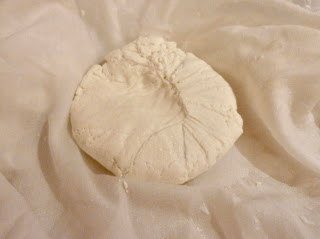The first time I decided to make palak paneer, I couldn't find the cheese. I postponed the dish until I did find some. More recently, Techie Smurf mentioned making his own. Soon after, Elizabeth Ingram made it for an episode of Quarantine Quitchen. So I decided to investigate.
The recipes I found are exactly the same as the one I posted for cottage cheese. They simply go a step farther and press the cheese into a block, which also removes more of the whey than simply straining it. It isn't any more time-consuming and produces a block of Farmer's Cheese ready to pan-fry.
Unlike my other recent from-scratch recipes, making paneer yourself is definitely cheaper than buying it. A quart of whole milk makes at least 5 oz, and 8 oz was $6 at the market.
I'm following the method from Swasthi's Recipes. I made a smaller batch than her posted recipe, and I'm adding a touch of salt. It's easy, not overly time-consuming, and definitely something I will consider making again.
1 quart whole milk
1/8 tsp salt
2 Tb (1 oz) apple cider vinegar
1. In a heavy saucepan over medium heat, warm milk and salt. Stir often at first, then almost constantly as the temperature gets above 150º, to reduce scorching. The reaction works as low as 145º, but I recommend getting the milk to 200º, slightly below boiling. The molecular structure of milk changes at this temperature and makes it conducive to all sorts of cheese and yogurt making. Also, if you're mildly but not completely lactose intolerant, this will make it easier to digest the final product.
2. Remove the pot from the heat and stir in the vinegar. Continue to stir for 1-2 minutes as the curds separate from the whey. Allow mixture to sit about 5 minutes, then stir a bit again, just to make sure all of the curds have separated.3. Place a cheesecloth or muslin over a strainer which is set over a bowl. Pour the whole contents of the saucepan into the strainer. Allow to drain for a minute, then remove the strainer to the sink and run cold water over the curds to remove any remaining vinegar. I've always thrown out the whey at this point, but it seems like such a waste that I quickly searched uses for it. I ended up saving it to be the liquid in the vegetable broth I was making the next day, since making it vegan wasn't necessary.4. Wrap the cloth around the curds and squeeze out as much whey and water as possible. Make a bundle with the cloth and hang it for 30 minutes to allow more water to drip out. I hung it over the kitchen faucet.5. The next step is pressing. Twist the cloth so the cheese inside is a disc. Place on a draining board or back in the sieve. Place a cutting board or skillet or some other heavy, flat item on top of the bundle. Then put several pounds of something on top of that. Allow cheese to press (room temperature is fine) for about 2 hours. This should get as much liquid out of the cheese as possible, so it can be unwrapped without crumbling. There will be a dent from the cloth, but it shouldn't be so deep that it makes the block fall apart. At this point, you can cut and use the cheese immediately or store for 2-3 days.
6. For troubleshooting issues, I refer you to the photo at the top of the post. One small part of the block was not twisted tight enough. Those curds crumbled when I cut it. There's nothing wrong with them; you can sprinkle them over your dish.7. Paneer has the cool (for cheese) property of not melting. It cuts and fries like extra-firm tofu. Or you can have it cold, which tastes like dry cottage cheese. Up to you.Makes about 5-6 oz
Difficulty rating π






No comments:
Post a Comment
I got tired of having to moderate all the spam comments and put back the verification. Sorry if it causes hassles.